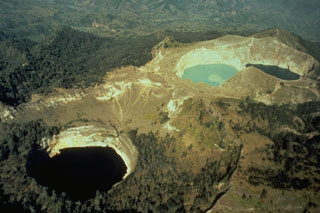Report on Kelimutu (Indonesia) — 18 September-24 September 2024
Smithsonian Institution / US Geological Survey
Weekly Volcanic Activity Report, 18 September-24 September 2024
Managing Editor: Sally Sennert.
Please cite this report as:
Global Volcanism Program, 2024. Report on Kelimutu (Indonesia) (Sennert, S, ed.). Weekly Volcanic Activity Report, 18 September-24 September 2024. Smithsonian Institution and US Geological Survey.
Kelimutu
Indonesia
8.77°S, 121.82°E; summit elev. 1639 m
All times are local (unless otherwise noted)
Pusat Vulkanologi dan Mitigasi Bencana Geologi (PVMBG) reported that monitoring data and comparisons of recent field observations at Kelimutu indicated decreasing activity. Bubbling along the NE coast of the lake in Crater I (Tiwu Ata Polo) was observed on both 15 and 21 September. The temperature of the lake water was 22 and 24 degrees Celsius on 15 and 21 September, respectively. The lake water changed from dark green to bluish green. Conditions at Crater II (Tiwu Koofai Nuwamuri) were stable during 15-21 September, characterized by light blue crater water with small sulfur deposits floating in the middle of the lake and along the edges, diffuse white emissions rising 5 m above the lake’s surface, and a water temperature of 30 degrees Celsius. The color of the lake water at Crater III (Tiwu Ata Bupu) remained dark green on 15 and 21 September, the lake water was calm, and the temperature was 21 and 22 degrees Celsius, respectively. Seismicity was lower in September compared to August. The Alert Level was lowered to 1 (on a scale of 1-4) at 1600 on 23 September and the public was advised to limit activities near the craters, not approach the lake water, and to not spend the night in the craters.
Geological Summary. Kelimutu is a small, but well-known, Indonesian compound volcano in central Flores Island with three summit crater lakes of varying colors. The western lake, Tiwi Ata Mbupu (Lake of Old People) is commonly blue. Tiwu Nua Muri Kooh Tai (Lake of Young Men and Maidens) and Tiwu Ata Polo (Bewitched, or Enchanted Lake), which share a common crater wall, are commonly colored green and red, respectively, although lake colors periodically vary. Active upwelling, probably fed by subaqueous fumaroles, occurs at the two eastern lakes. The scenic lakes are a popular tourist destination and have been the source of minor phreatic eruptions in historical time. The summit is elongated 2 km in a WNW-ESE direction; the older cones of Kelido (3 km N) and Kelibara (2 km S).
Source: Pusat Vulkanologi dan Mitigasi Bencana Geologi (PVMBG, also known as CVGHM)

